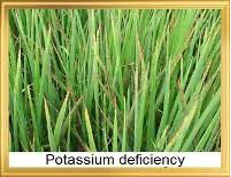
Potassium (K) Deficiency

Potassinum deficiency affects on photosynthesis and growth rate. Potassium is important for all growth stages of rice.
Potassium deficiency occurs under the following conditions -
1. Excessive use of nitrogen fertilizer (or) N and P fertilizers with insufficient potassium(K) application
2. Direct seeded rice during early growth stages, when the plant population is large and root system is shallow
3. Difference on susceptibility to potassium deficiency of each variety
How to identify (symptoms)
Stunted plant growth and reduced tillering. Plant lodging and dark green leaves. Lower older leaves become yellowish color from tips to midrib and later dry up and turn to pale brown. Presence of brown spots on dark green leaves. Panicles become small and long due to leaves formation on panicle by abnormal dead tissue. Wilting of leaves due to unbalance ratio of potassium and nitrogen (high potassium and low nitrogen).

How to manage
1. Estimate potassium available source in the region
2. Carry out deep tillage to improve roots’ health and increase potassium uptake
3. Use high-quality seeds and establish optimal plant population and carry out proper water management
4. Plough and submerge straws and crop residue. If straw buring is the only option for crop residue management, spread the straw evenly over the field and burn and spread the ash evenly over the field.
5. Apply optimum doses of nitrogen and phosphorus fertilizers and micro-nutrients. Apply potassium fertilizers, farmyard manure, or other materials (rice husk, ash, compost) to replenish potassium removed in harvested crop.